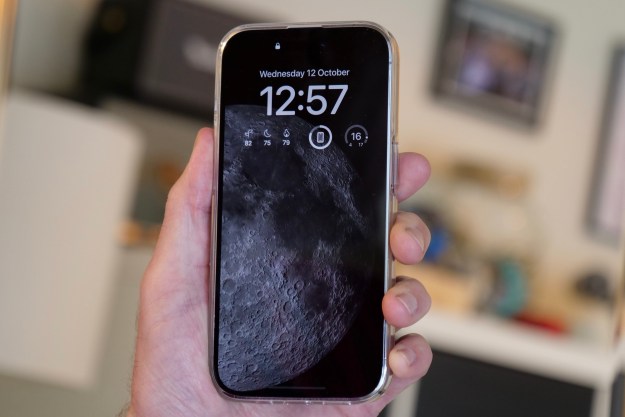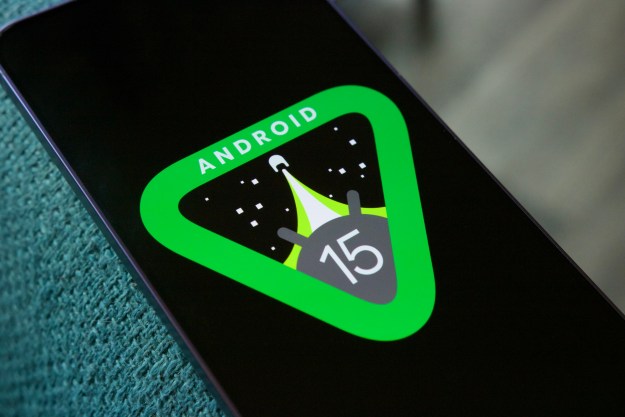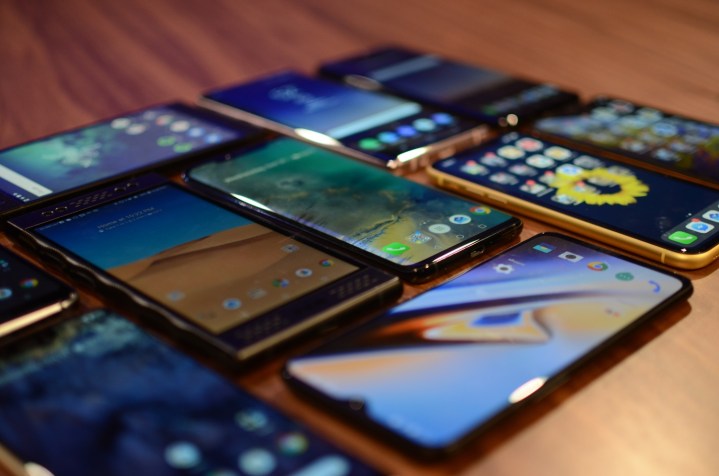
October is usually the spookiest month, but it wasn’t the decorative cobwebs or our co-workers’ pre-coffee faces that terrified us this year — it was the scary amount of mobile handsets released by manufacturers around the world. Almost every major smartphone company dedicated themselves to an October release, leading to a jaw-dropping number of new phones in a short period of time. No one will blame you if you missed a couple, so if you’re worried a phone slipped under your radar, or if you’re looking for a recap, we’ve put together this list of all the phones (in no particular order) released and revealed in “Techtober.”
iPhone XR
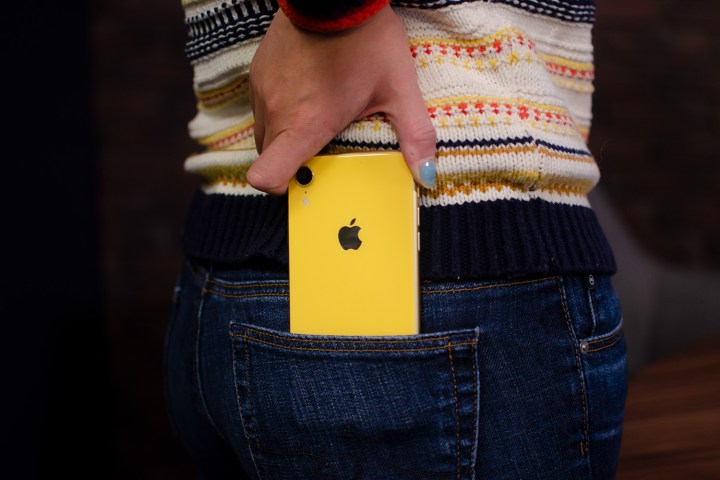
The iPhone XR was announced at Apple’s September iPhone event, but it’s one of the biggest phones to release in October. The iPhone XR plays second fiddle to the iPhone XS and XS Max, but it’s the iPhone most people should buy thanks to its $750 price tag. It’s equipped with the same incredibly powerful A12 Bionic processor as the other two phones, a battery that can last as long as its big brothers, and wireless charging support. But where the iPhone XR stands out is its collection of vibrant color options we can’t stop admiring.
The XR is only equipped with a single-lens camera on the back, but it’s not a downgrade. While some users may yearn for the 2x optical zoom telephoto lens on the XS and XS Max, the camera still performs extremely well. In fact, in our Portrait Mode test, the iPhone XR came out on top over the iPhone XS. But the spotlight feature again is the iPhone XR’s price, — you’re getting a lot for less.
Read more
Honor 8X

It’s not just flagship phones that saw the light of day in Techtober — Huawei sub-brand Honor also made sure to get an early offering in with the budget Honor 8X. Honor’s latest budget phone comes with a sleek glass body and a bezel-less design that’s reminiscent of the newest iPhones. A small notch at the top of the screen houses the front-facing camera, and the dual-lens cameras on the back produces solid photos — though the results are not always consistent.
It’s powered by the Kirin 710 processor, which provides more than enough grunt for most day-to-day tasks. Mobile gaming shouldn’t be too much of a problem thanks to the incorporation of the GPU Turbo mode that supercharges gaming performance. That’s joined by face unlock, and a large 3,750mAh battery. The inclusion of a MicroUSB port is a disappointment these days, but forgivable given the phone’s other successes.
Read more
LG V40 ThinQ
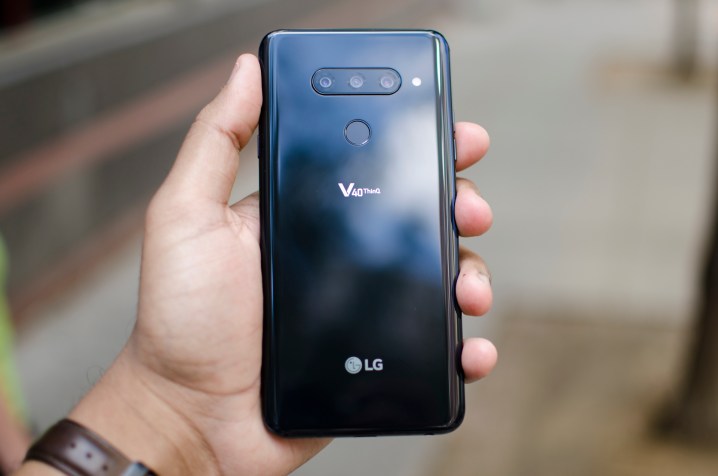
LG wasn’t taking no for an answer this year, and the October release of the LG V40 ThinQ marked its fourth flagship release of the year. LG pulled out all the stops for this phone, as the V40 ThinQ rocks an incredible five camera lenses spread across the front and back of the phone. There are three lenses on the back, with the primary lens being joined by a wide-angle and telephoto lenses. It’s undoubtedly the most versatile phone camera LG has ever offered, and it was a joy to play with. However, consistency between the lenses was missing, and there was a clear difference in low-light performance depending on which lens was currently in use. Still, it was a solid improvement over the LG G7 ThinQ.
The phone is smooth and sleek, with a beautiful glass design that feels great in the hand. There’s a huge 6.4-inch OLED display running a super-sharp 3,120 x 1,440 pixel resolution. You’ll also find a notch at the top of the display — a trend we saw many manufacturers play with throughout October. This year’s powerful “flagchip” — the Snapdragon 845 — powers the phone, along with 6GB of RAM, and a 3,300mAh battery that lasted a day — but likely no more. It’s a solid phone, but one we hesitate to recommend at its initial $900 asking price.
Read more
Nokia 7.1

October also introduced us to the impressive midrange Nokia 7.1. It’s a great-looking phone that incorporates a lot of top-level flagship trends, including an edge-to-edge design and a notched screen. The sizable chin at the bottom looks a bit dorky, but it’s still an impressive look for a phone that costs $350. The 5.84-inch LCD display runs a 2,280 x 1,080 pixel resolution with HDR10 support, and it’s powered by Qualcomm’s Snapdragon 636 processor. Performance is relatively snappy, and there’s plenty of storage with a MicroSD expansion slot.
You’ll find two camera lenses around the back of the phone, and a single selfie lens at the front. Photos are solid, and it comes with support for Nokia’s “Bothie” mode — where a picture is taken with both cameras at once. There’s even a portrait mode available. The battery is decently sized, coming in at 3,060mAh. Nokia also claims the USB-C fast charging will see the phone recover 50 percent battery in just 30 minutes — but we’ve yet to test it. All in all, the Nokia 7.1 is an extremely solid midrange phone with a lot of features you wouldn’t expect to see on a $350 phone. It’s worth a look if you’re phone shopping on a budget.
Read more
Sony Xperia XZ3

Sony isn’t one to be left behind — it also released a flagship phone in October, revitalizing the XZ range with the new Xperia XZ3. If you’ve been paying attention, you’ll find some similar-looking specs here — the Snapdragon 845 is back again, alongside 4GB of RAM and 64GB of storage — and it sports a similarly high level of performance compared to other flagship Android phones released this year. The design is nice too, with slimmed-down bezels that help this large phone feel smaller. However, that sleek design also makes it slippery — and the fingerprint sensor is poorly placed.
The huge 6-inch OLED display is definitely a high point of the phone, and it runs a crisp 2,880 x 1,440 resolution with HDR10 support and some wonderful customization tools. It’s easily on par with the other top phones of the year in terms of the display. Unfortunately, that polish doesn’t extend to other parts of the phone, and the single-lens camera on the back of the phone was a letdown, with poor performance in lower lights and a sluggish camera app. You’ll find Android 9.0 Pie on here, which is nice, but with a price of $900, you might find it hard to justify buying it over the competition.
Read more
Pixel 3 and Pixel 3 XL
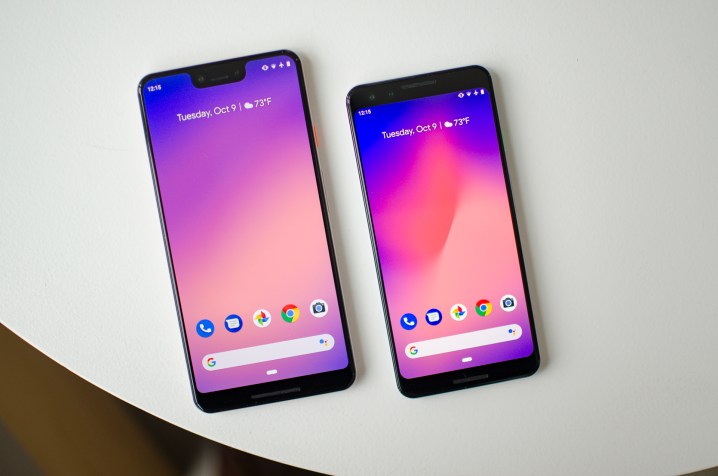
October is Google’s traditional stomping ground, and 2018 was no different. Just when we were thinking we’d had enough phones this month, along came Google with two new devices. Despite two different designs, almost everything else is similar between the Pixel 3 and Pixel 3 XL, minus screen size and battery. The Snapdragon 845 is joined by super-smooth, almost-stock Android software. Both phones keep to Pixel tradition too, eschewing multiple camera lenses for just a single lens on the back that provides absolutely incredible shots in a variety of different lighting and scenarios. Google did, however, sprinkle in a little more with an extra-wide-angle lens on the front, joining the primary selfie snapper.
A big part of the Pixel 3 range’s success in photography and performance lies in Google’s embrace of A.I. optimization. Artificial intelligence now handles a huge swath of operations on the Pixel 3, from identifying the perfect shot to answering suspected spam calls with Call Screen. Battery capacity is on the lower side for both phones, and you’ll likely be looking to juice up later in the day regardless of which one you pick. However, it’s probably our biggest gripe with these phones (outside of the Pixel 3 XL’s notch), and these two phones are among of the best Android phones you’ll find this year.
Read more
Pixel 3 review | Pixel 3 XL review
Razer Phone 2

The rise of “gaming” phones has been something to behold. This series of phones with top specs are optimized toward mobile gaming, and usually come with gamer-friendly designs — i.e., RGB lights and sharp angles . The original Razer Phone all but kicked the trend off last year. So we were excited to see the upgraded Razer Phone 2 arrive with its angular design and newly added RGB-lit logo.
It packs the usual tech upgrades and high numbers you’d hope for in a gaming phone — the Snapdragon 845 and 8GB of RAM — and it provided spectacular gaming performance in every game we threw at it. The incredible 120Hz Ultramotion display has to be seen to be believed, and the extra smoothness really cements the top-level gaming performance. Like the previous year’s Razer Phone, the speakers were stupendously loud and clear, while the 4,000mAh battery offers more than enough juice for long gaming sessions. But it’s not all good. Despite improvements, the Razer Phone 2’s camera is still mediocre, and there’s no Android 9.0 Pie yet. It’s also seen a slight price increase to $800. But Razer has its fans, and the Razer Phone 2 could still do well.
Read more
Samsung Galaxy A9

The Galaxy A9 is Samsung’s first stab at reinvigorating its midrange entrants in a Huawei-dominated market — and it’s an interesting prospect for sure. The most obvious addition is the sheer amount of camera lenses. Like the LG V40 ThinQ, there’s five in total — but the A9 squeezes four of them onto the back. It’s a world’s first for this amount of lenses on a phone, and it seems utterly bonkers. It leads to an exceptionally versatile camera though, and one well worth playing around with. The design has slim bezels and smooth curves — but it’s the range of colors that really catches the eye.
You’ll find Samsung’s own user interface here, laid over Android 8.0 Oreo. Performance is solid thanks to the Snapdragon 660 processor, and while it won’t be showcasing flagship speed, it’ll be fast enough for most people. The large 3,800mAh should also easily last a day — and there’s fast USB-C charging. The real sticking point is the price. At 550 British pounds, the A9 costs over $700 U.S. — which isn’t really mid-range pricing to us.
Read more
Samsung Galaxy A9 2018 hands-on review
Huawei Mate 20, Mate 20 Pro, Mate 20 X, and Porsche Design Huawei Mate 20 RS

As is now fairly usual behavior, Huawei saw what everyone else was doing this month and dialed things up to 11. October saw not one, not two, but four new phones from Huawei — all of them entries in the Mate 20 range. Huawei’s new, exceptionally powerful and A.I.-boosted Kirin 980 processoe powers each of these four phones, and there are also three camera lenses on the back of each — consisting of a primary lens, a wide-angle lens, and a telephoto zoom lens. Each also runs the latest EMUI 9.0 software, running over Android 9.0 Pie. But while they all share that in common, there are small differences that make each phone special.
The Mate 20 comes with a huge 6.53-inch LCD display, complete with a small “dewdrop” notch that’s easily one of the best notch implementations we’ve seen yet. The camera suite consists of a primary 12-megapixel lens, a 16-megapixel wide-angle lens, and an 8-megapixel telephoto zoom lens. The Mate 20 Pro is clearly the super-premium model though, with a 6.4-inch AMOLED display complete with in-display fingerprint scanner, and a triple-camera system that consists of a stupendous 40-megapixel primary lens, a 20-megapixel wide-angle lens, and an 8-megapixel zoom lens. The Pro does come with a more usual screen notch though, thanks to its advanced face-unlocking tech.
The Mate 20 X is the bizarre middle child. It’s equipped with the same specs as the other phones, but it packs a titanic 7.2-inch screen. Huawei has touted it as being a phone for Nintendo Switch-level mobile gaming. Finally, the Porsche Design Huawei Mate 20 RS continues Huawei’s partnership with Porsche, squeezing the Mate 20 Pro’s specs into a luxurious glass-and-leather frame. There’s far more to talk about on each of these phones than we can feasibly cover here — but suffice to say that Huawei may have released a few of the best flagship phones of the year, all in the same month.
Read more
Huawei Mate 20 hands-on review | Huawei Mate 20 Pro hands-on review | Huawei Mate 20 X hands-on review | Porsche Design Huawei Mate 20 RS hands-on review
Palm (2018)
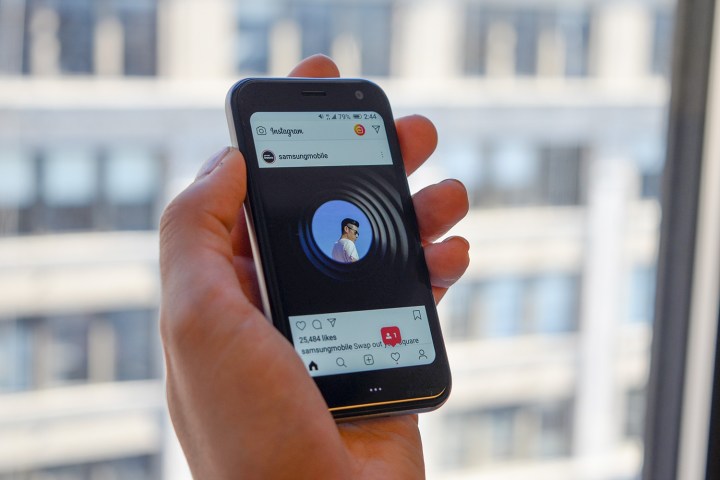
One of October’s weirdest releases was Palm’s attempt at making a non-phone. That is, a replacement phone that reduces your normal phone usage by … being a normal phone. In essence, the Palm is designed to be an alternative device to your main phone that you can pick up and use whenever you want to be less tied to your phone. Notifications are sent to the Palm from your usual phone through Verizon’s NumberShare feature, and it’ll get all the same notifications on Android 8.1 Oreo. The twist is that the Palm’s screen doesn’t light up when notifications arrive — which Palm believes will cut down on people being obsessed with their phone. It’s certainly an odd product angle, and one that our own senior writer Andy Boxall was quick to comment on. At $350, it’s a tough sell — especially when iPhone interactivity is limited, and many Do Not Disturb modes on smartphones fulfill the same niche.
Read more
Asus ROG Phone

Razer isn’t the only company to pump out a gaming phone this October. Republic of Gamers — the gaming arm of tech giant Asus — finally released its highly anticipated gaming phone, the Asus ROG Phone. Like most other gaming phones, the Asus ROG Phone comes with some spectacular hardware — in particular, our old friend the Snapdragon 845. However, Asus has reportedly overclocked the 845’s clock speed to 2.96Ghz, exceeding the usual 2.8GHz speed. Squeezing the phone’s sides will activate X Mode, which shuffles active processes over to the fastest cores, boosting gaming performance. It comes with a glass-and-metal build, and a design that’s clearly meant to appeal to gamers. There’s also a massive 4,000mAh battery that will power those gaming marathons. We’re still working on our Asus ROG Phone review, but we’ll have our impressions up soon.
Read more
Xiaomi Mi Mix 3

Xiaomi isn’t a newcomer to the mobile scene by any means, but the Chinese company is redoubling its efforts in global marketplaces, and the announcement of the Xiaomi Mi Mix 3 is likely to be pivotal for its success there. We’re used to high-powered flagships, but Xiaomi is pushing the Mi Mix 3 as something else entirely. The familiar Snapdragon 845 makes an appearance, but it’s joined by a ludicrous 10GB of RAM — a first for a smartphone. It’s also going to be capable of accessing 5G networks when it launches, making this a very futuristic phone.
But the fun doesn’t stop there. The Mi Mix 3 also comes with an exceptionally bezel-free appearance too, and Xiaomi boasts about a 93.4-percent screen-to-body ratio, which it achieved with a pop-up camera design similar to the Oppo Find X. Unlike the mechanical Find X, the Mi Mix 3’s camera is physically pushed up, and has been relentlessly designed to feel comfortable. There’s a dual-lens camera on the back, complete with “bokeh” background blur effects. While we’re not sure if this phone will reach the U.S., it may release in global markets eventually. It costs around $475 in China.
Read more
RED Hydrogen One

If you’re looking for a phone like no other, then the RED Hydrogen One could well be one of the most unique phones we’ve ever reviewed — but it has severe drawbacks. It’s certainly a different-looking phone, even when compared to some of the more unique-looking gaming phones we’ve reviewed this year. The RED Hydrogen One resembles RED’s camera gear, with Kevlar panels, grippy protrusions, and chunky bezels that house front-facing speakers. The really important bit is the screen though. It supports (according to RED) “better-than-3D” content, thanks to the 4-view display. It’s a truly impressive-looking spectacle when you see your first 3D image on the screen — but its novelty wears off fairly quickly, and it’s fairly close to just being a gimmick.
Weirdly, you’ll find last year’s Snapdragon 835 here, and the phone oddly stutters a little. The 4,500mAh battery is excellent though, and it can easily last two days on normal usage. The camera supports taking images in the display’s “4-View” mode, but it’s otherwise average. “Average” is certainly not a word to want to hear when you look at the price. The RED Hydrogen One starts from $1,295, with the price rising to $1,595 for the model with a titanium build. That’s a lot of cash.
Read more
OnePlus 6T
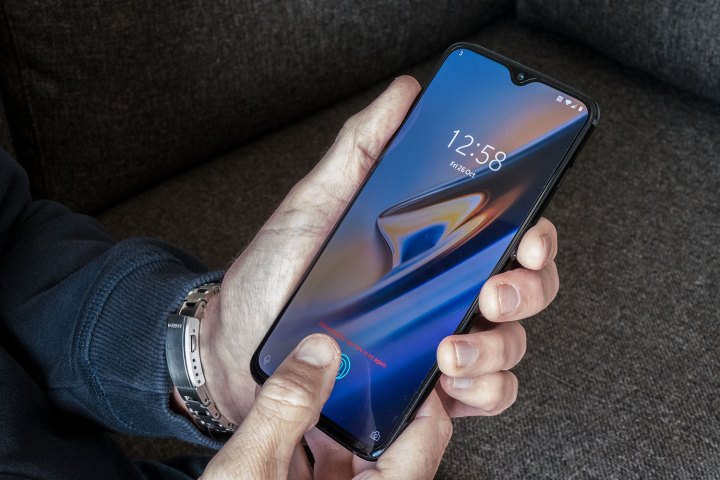
OnePlus releases a new phone twice a year — but if you think that means it’s slacking off, then the OnePlus 6T is proof is isn’t. As befits OnePlus’ reputation, the OnePlus 6T is packed with all the top hardware you expect from the “flagship killer.” The Snapdragon 845 makes yet another appearance, along with at least 6GB of RAM and a 3,700mAh battery. The dual-lens camera from the OnePlus 6 returns, but the software has been tweaked to provide better performance.
You’ll find most of the OnePlus 6T’s advances on the exterior though, and the design is one of the most striking. The OnePlus 6’s chunky notch has been replaced by a dewdrop-style notch, similar to the one seen on the Huawei Mate 20. But what’s missing is just as notable as what has been added — the fingerprint scanner that used to sit below the camera on the back has disappeared completely. Instead, OnePlus has added an in-display fingerprint scanner, so you’ll now be able to unlock your phone by pressing your finger to the fingerprint icon on your screen. Also, this is the first OnePlus phone available from a carrier in the U.S. (T-Mobile), and it also finally supports Verizon’s network.
Read more
ZTE Blade Max View and ZTE Blade Max 2s

Did you think the OnePlus 6T would be the last phone announced in October 2018? ZTE hasn’t had much action this year, so it sneaked a couple in before October closed. The ZTE Blade Max View and Max 2s are two budget phones in the sub-$200 bracket that aim to provide great value for money. Both come equipped with a 6-inch LCD display that runs a more-than-respectable 2,160 x 1,080 resolution. There’s an undisclosed Qualcomm Snapdragon chip powering each, but you’ll find slightly more RAM on the more powerful Max View, as well as a dual-lens camera setup.
Read more
ZTE Blade Max View and Blade Max 2s news
Editors' Recommendations
- Are you having iPhone alarm problems? A fix is coming soon
- iPhone 16: news, rumored price, release date, and more
- AirTags range: here’s how far the tracker can reach
- Best iPhone deals: Save on iPhone 15, iPhone 15 Pro Max and more
- iPhone SE 4: news, rumored price, release date, and more
